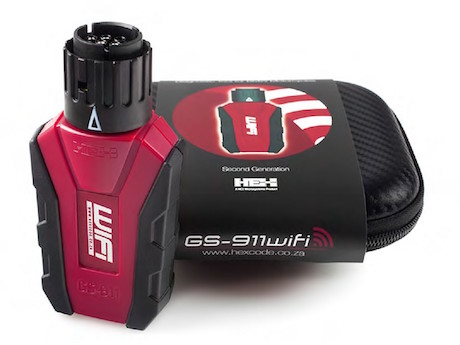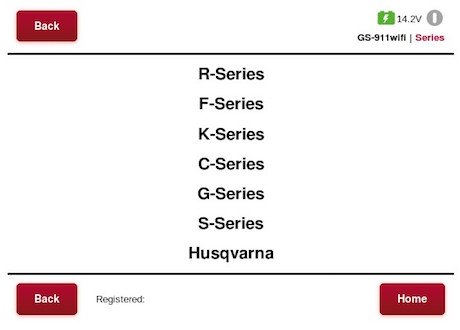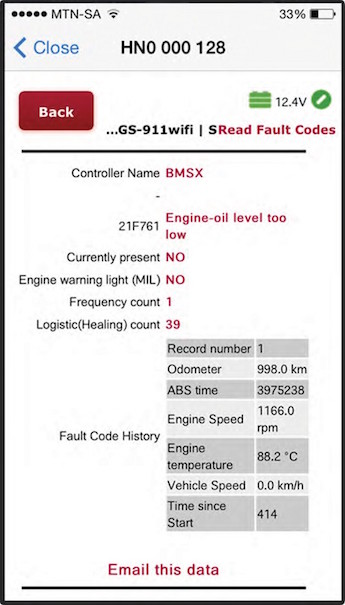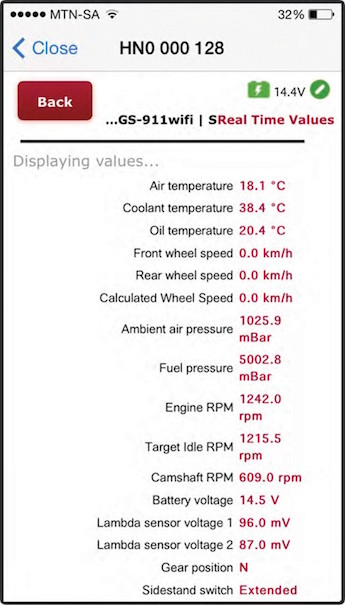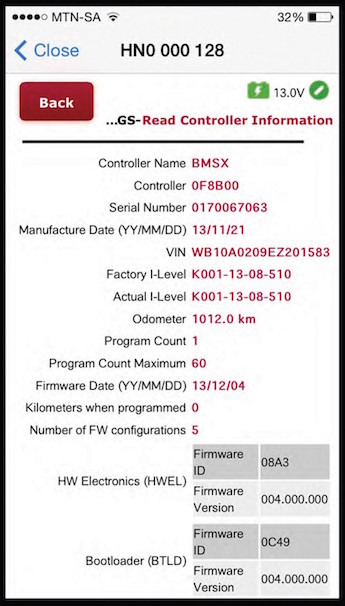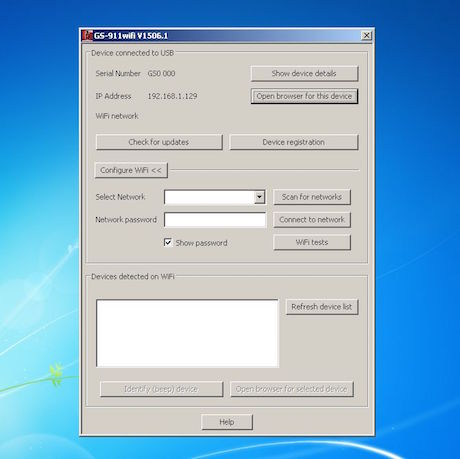Now you can get engine faults sent to your smartphone via wifi, reports Wayne Carruthers.
It works the same way that an obd2 scanner works for the car.
BMW owners have long had the GS911 to carry as a diagnostic tool for the intelligent ECUs fitted to their machines enabling diagnosis in the workshop via USB interface and out on the road via bluetooth to mobile devices. It is the Swiss Army knife of diagnostics for BMW owners. Check ToolsPatrol for expert advice on tools.
The South African manufacturer of the GS911, Hexcode, released a new version of the GS911 called the GS911 WiFi into the US market last year. The model was quietly released into the rest of the world and Australia early in 2015.
The latest model BMWs like the K1600 and R1200GSW moved to the faster CAN-Diag protocol which required a new hardware design to support the models so the GS911 WiFi with K-Line and CAN-Diag interfaces was developed. Support for these new models is being progressively rolled out.
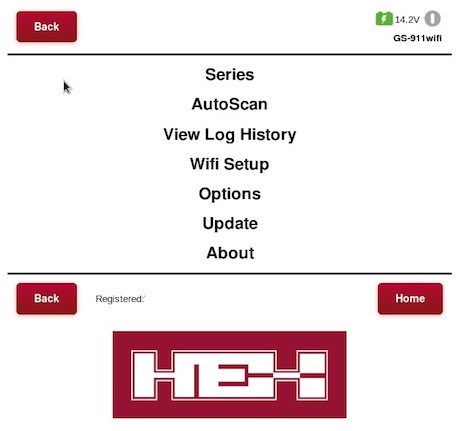
The new model replaces the bluetooth interface with a WiFi interface which better suits the modern smart phones and tablets we all use in the modern world. The adoption of the WiFi interface also opens up the possibility of cloud services to owners with more functionality out on the road and more timely updates to the software for new models as they are released.
The GS911 WiFi also supports the Husqvarna Nuda and Terra models released by Husqvarna while it was under BMW ownership.
While the GS911 was originally designed as a BMW diagnostic tool the advent of coding and customisation in the newer BMW models has meant the GS911 has had to evolve into a tool which supports coding and customisation. This support is enhanced in the new GS911 WiFi.
A new feature which the WiFi version also introduces is the ability to log real time data from ECU sensors to internal storage for extended periods enabling owners to track down intermittent faults. Real time logging is able to be set at the start of a journey and continue throughout the day regardless of how many fuel or coffee stops a rider may take. In fact it could be set up to record for up to a year.
Development of the GS911 has not only been done in the lab in South Africa, Hexcode have an active program involving owners who test firmware and software in the field and put forward ideas or features which are needed. Hexcode have been responsive to riders needs which is why the product has been so successful.
Lisa and Simon of 2RideTheWorld are one couple who have been involved with the development from the beginning and regard it as important as your keys in the 526,000 kms they have covered in their 11-year travels.

When delivered the GS911 WiFi is well presented in a nifty travel pack with the GS911, a USB cable for MAC/PC connection and an instruction sheet as well as some decals. The first step is to log onto the Hexcode web site and download the WiFi Utility for either Windows or MAC which enables registration of the unit, update to the latest firmware, connection of the GS911 to your home WiFi Network and launching a web browser to access the web interface of the GS911.
Connection of a new device to a network can be challenging at times but the Hexcode WiFi Utility makes the process easier than any other device I have seen. The GS911 Android utility is available from the Google Play Store.
In operation the new WiFi is child’s play. The WiFi can be either connected to your home WiFi network or connect direct direct to a mobile or tablet in adhoc mode then browse the menus. Up to 10 WiFi networks can be stored in the unit and automatically connect when the networks come into range. Selection of network is done with a push button on the end of the unit with LEDs to indicate when connection is successful.
The ability to auto connect has been the joy of the device for this writer in setting up logging from the comfort of the home PC before heading out for ride then downloading the data sitting at the home PC with a cup of coffee in hand on return.
Hexcode have kept the web interface to a minimalist design to ensure it is fast and responsive. From the main menu an autoscan will determine the model of the vehicle and return all of the information on each of the ECU’s fitted. This can then be emailed for future reference. Individual ECU functionality is selected from the Series menu in line with the traditional PC application.
The user interface uses the menu items plus back and home keys. If there could be any criticism of the web interface it would be that the lack of an extra button going direct to the relevant model series menu after an autoscan increases the number of key strokes and perhaps the use of a 2 column layout for some menu’s like the series menu to minimise scrolling.
In the time the unit has been under test it has been used to confirm the firmware revisions of ECUs, whether dealers have actually done updates to ECUs, quickly identify faulty sensors and then with the real time data confirm the replacement sensors are operating correctly plus reset adaptions to integrate the sensors as well. On one of the newer models, determining whether the engine ECU was operating in closed or open loop when a particular fault was occurring was made easy with the real time logging.
To prove the reliability of the real time logging the unit was set up to record all engine sensors and parameters for a 475km trip, just to make it harder the unit was set to record a firmware debug logging file as well, the full set of data was there at the end of the trip. Recovering the data was simple to download from the web interface and automatically open in a spreadsheet to analyse. It could just as easily have been opened into a graphing program.
The traditional PC application for maintenance functionality via USB connection is still supported and is downloaded separately from the Hexcode web site. The progressive introduction of cloud services will bring maintenance functions into the web interface. At the current time cloud services are limited to the new K001 models. Hexcode are wisely taking a conservative approach to ensure the operation of cloud services are robust and reliable.
While downloading the applications rather than supplying them on CD/DVD may seem complicated it ensures the software is up to date and it also guards against the counterfeit products which have plagued manufacturers in recent years.
Support for the product is done via on line support tickets with the Hexcode staff as well as a self help user forum. A neat feature is the ability to email information direct from the WiFi web interface to the Hexcode support desk where support is needed.
The full feature set for the BMW models in each mode of operation is too lengthy to include here. It is all on the Hexcode website in a function chart, but in general terms functionality can be considered in three modes:
- Service Functionality for the Workshop such as Service Reminders, Output Device Function Testing, Calibrations, Clearing and Relearning Adaptions and ABS brake bleeding.
- Emergency Functionality out on the road such as ECU information, reading and clearing fault codes for all the intelligent control units plus viewing or logging of the real time sensor data.
- Cloud Functionality which is being introduced in a staged manner to bring more of the Service Functionality to the rider while out on the road but accessible from MAC, Linux, IOS, and Android devices
Over time as the level of electronics in machines increases, tools like the GS911 WiFi will become as essential as the trusty spanners.
The Australian Distributor of the GS911 ($A550) is MotoHansa in Sydney.
The GS911 WiFi is available in enthusiast and professional versions, the enthusiast version allowing use of maintenance functions on 10 VIN’s and the unlimited VIN professional version. Hexcode also have an extension cable available to enable placing the WiFi into a tank or tail bag.”
In 2018 Hexcode released another 2 models of the GS911 to suit the move to EU4 BMW models with the 16 pin OBDII connector used in cars for many years, plus Hexcode released adaptor cables to enable the older GS911 WiFi diagnostic devices to connect to the EU4 compliant models.
There are now 2 models of the GS911 WiFi, GS911 WiFi – 10 pin Connector, GS911 WiFi – OBDII Connector both available in Enthusiast or Professional versions plus a GS911 USB Generation 2 enthusiast only model for those wanting a lower cost wired only device
There are two adaptor cables, Male OBD Adaptor cable for connecting the older 10 pin GS911 WiFi to new OBDII connector bikes plus a Female OBD Adaptor cable for connecting the new GS911 WiFi & USB models to the older BMW bikes with the 10 pin connector


